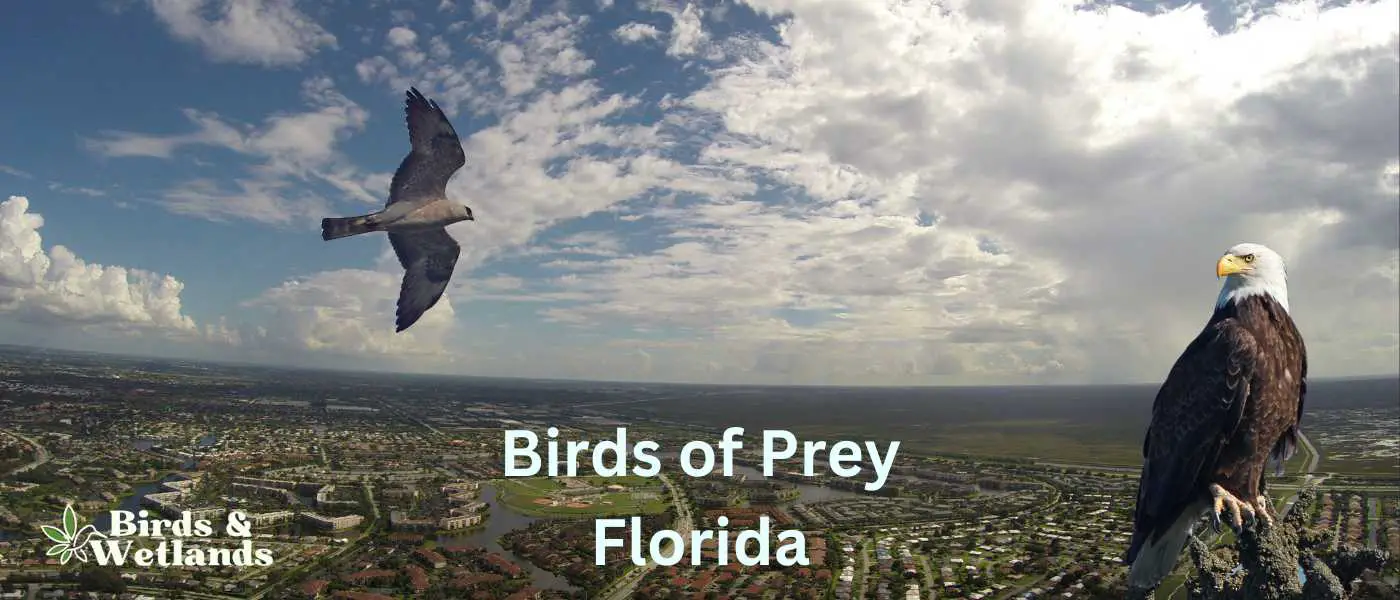Bathed in year-round sunshine and defined by diverse landscapes, Florida is a treasure trove of unique wildlife, with birds of prey playing a particularly compelling role. From the quiet backwaters to the vibrant coasts, these raptors grace the skies with their grandeur, embodying the dynamic spirit of the Sunshine State. Their presence, ranging from the common to the rare, contributes to the rich tapestry of Florida’s vibrant ecosystems.
List of Birds of Prey in Florida
Eagles – Bald Eagle (Golden eagles are rare visitors as well)
Falcons – Peregrine Falcon, Merlin, American Kestrel (Gyrfalcon is a rare visitor)
Hawks – Sharp-shinned Hawk, Cooper’s Hawk, Short-tailed Hawk, Red-tailed Hawk, Red-shouldered Hawk, Broad-winged Hawk, Mississippi Kite, White-tailed Kite, Northern Harrier (Goshawk and Rough-legged Hawk are rare visitors)
Kites – Swallow-Tailed Kite, Snail Kite
Owls – Barred Owl, Great Horned Owl
Vultures & Others –Turkey Vulture, Black Vulture, Osprey, Limpkin (Common Buzzard is a rare visitor)
Bald Eagle (Haliaeetus leucocephalus)

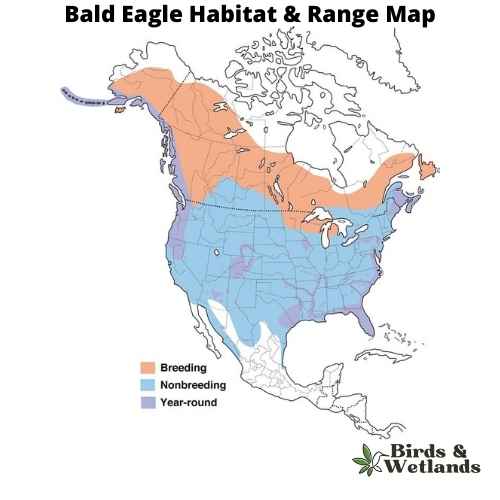
Bald Eagle Sound
Scientific Name: Haliaeetus leucocephalus
Length: 28–40 in
Wingspan: 5 ft 11 in and 7 ft 7 in
Weight: 6.6 -13.9 lb
The Bald Eagle, primarily found in Canada and Alaska, is instantly identifiable by its white head, dark brown body, yellow beak, and a piercing cry. Its sharp, orange-yellow eyes aid in efficient night hunting.
Predominantly residing in North America, occasionally venturing into Asia and Europe, it thrives near water bodies. It perches atop trees, providing a bird’s-eye view of its prey. It feeds on fish, carrion, small mammals like rabbits and squirrels, and reptiles. Hunting involves a swift downward swoop to seize the prey, carrying it back to the nest.
Bald Eagles are monogamous, forming lifelong pairings. They construct vast nests from sticks, lined with moss or grasses. They typically lay 1-3 eggs annually, which hatch around 35 days later. The fledglings leave the nest roughly 6 weeks after hatching, but continue to rely on their parents for nourishment for a further 5-6 months, until they become proficient hunters.
Peregrine Falcon (Falco peregrinus)


Peregrine Falcon Sound
Scientific Name: Falco peregrinus
Length: 14.2-19.3 in
Wingspan: 39.4-43.3 in
Weight: 530-1600 g
Known for its blue-gray plumage and unique cheek bars, the Peregrine Falcon stands as a beacon of power and swiftness. Despite its modest size, it reigns as the world’s fastest creature, reaching staggering speeds up to 240 mph during hunting dives.
Its diet mainly includes birds, occasionally bats, caught in an enthralling aerial display of agility and precision. Adapting to diverse habitats, this bird graces every continent except Antarctica, finding home in environments from city skyscrapers to towering cliffs.
Peregrine Falcons, monogamous in nature, often pair for life, expressing their bonds through complex courtship flights filled with intricate aerial maneuvers. They construct simple scrape nests on high ledges, often without adding materials.
Their parenting duties are shared, from egg incubation to feeding and caring for the chicks, ensuring their offspring are ready to take on the skies in their own time.
Merlin (Falco columbarius)

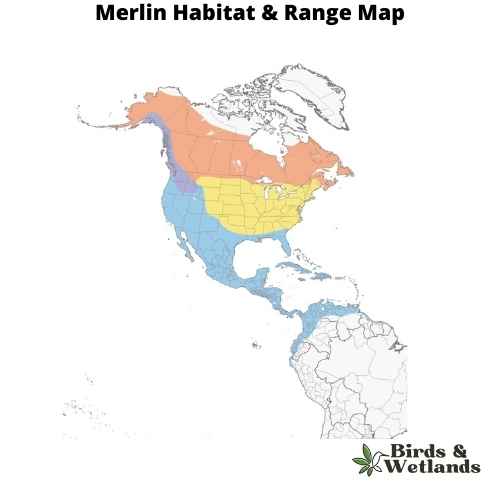
Merlin Sound
Scientific Name: Falco columbarius
Length: 9.4–13.0 in
Wingspan: 20–29 in
Weight: 5.8 – 8.1 ozz
The Merlin is a small, robust falcon known for its blue-gray or dark brown upperparts and thinly streaked, buff to orange underparts. Unlike other falcons, it has faint facial markings, offering a more uniform look.
This compact bird, renowned for its hunting prowess, chases down small birds in mid-air, exemplifying its impressive speed and agility.
Residing across northern North America, Europe, and Asia, the Merlin prefers open or semi-open landscapes. Rather than constructing their own nests, they tend to reuse old crow or raptor nests, or choose to nest on the ground in open habitats.
During courtship, males perform elaborate aerial displays. Both parents share egg incubation duties, with the male also responsible for feeding the family, reflecting the Merlin’s fascinating role in the biodiversity of its ecosystems.
American Kestrel (Falco sparverius)
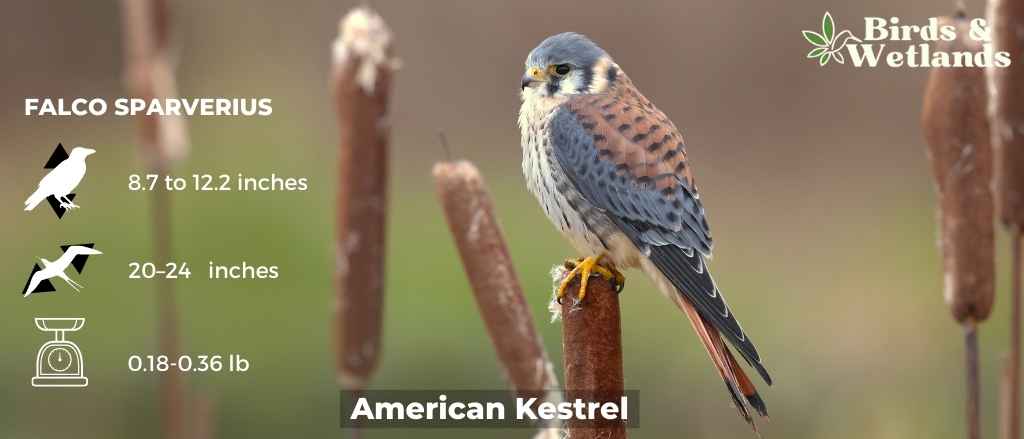

American Kestrel Sound
Scientific Name: Falco sparverius
Length: 8.7 to 12.2 in
Wingspan: 20–24 in
Weight: 3.0–5.8 oz
The American Kestrel, often recognized as the smallest and most brightly colored falcon in North America, exhibits a stunning array of rufous, blue and gray hues in its plumage. This bird, ranging in size from a mere 22 to 31 cm, carries distinct black facial markings that contrast with its white cheeks and has blue gray wings. Despite its small stature, the American Kestrel is a formidable predator, employing a unique hunting strategy that involves hovering at a height before swooping down on prey, primarily consisting of insects, small mammals, and occasionally small birds.
Residing predominantly in North and South America, the American Kestrel exhibits a preference for open habitats such as meadows, grasslands, and deserts. They are also found in both urban and suburban environments, nesting in cavities in trees, cliffs, buildings, and other structures. Kestrels are monogamous, with both sexes participating in the courtship displays that involve aerial acrobatics and feeding rituals. Nesting duties are a shared responsibility, with the male initially scouting for suitable locations and the female making the final selection. Both parents contribute to the incubation of the eggs and care of the young, ensuring the perpetuation of this captivating species.
Sharp-shinned Hawk (Accipiter striatus)
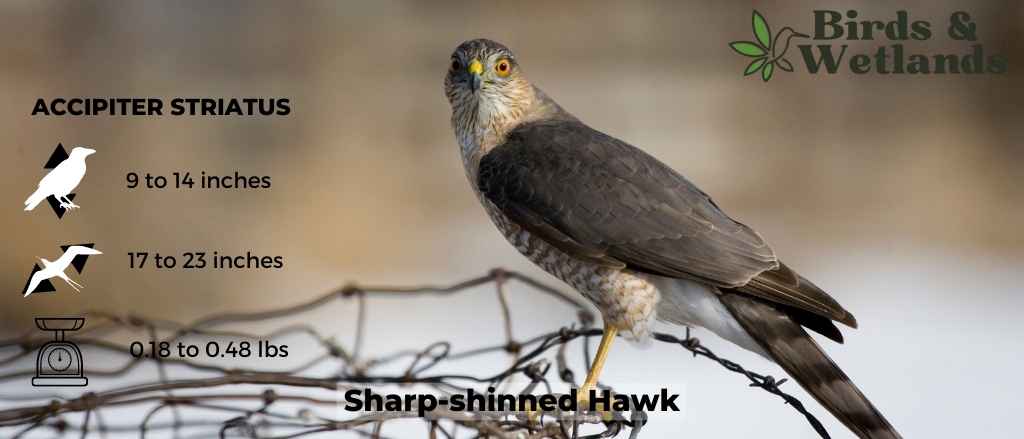
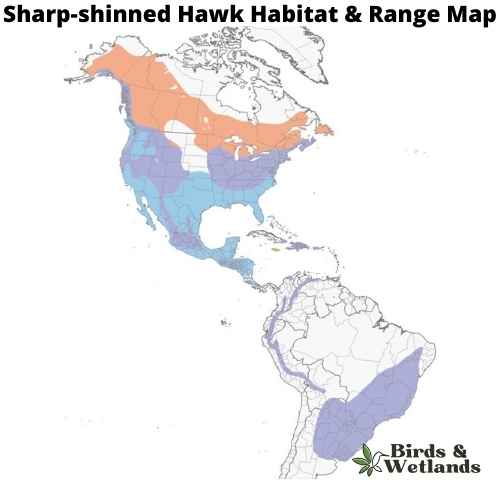
Listen:
The adult bird is brown on top and white underneath, with a dark brown band across its chest. It has short, rounded wings and a long tail that makes it look larger than it actually is. Adult sharp shinned hawks have black eyes, which are surrounded by white feathers. The female Sharp-shinned Hawk is browner than the male, who has darker brown markings on his back.
Sharp-shinned Hawks prefer open country for their habitat, including fields and meadows where they can hunt for mice and other small animals. They can be found throughout the United States but are most common in the east.
Sharp-shinned Hawks eat mostly small birds, such as sparrows and warblers, as well as small mammals such as mice and gophers. They catch prey by surprise using their incredible speed and agility, diving out of the sky at speeds up to 200 mph.
Sharp-shinned Hawks have an unusual hunting style for hawks—they prefer to catch their prey from perches above trees or telephone wires, rather than swooping down from above like most other hawks do and can often be seen hunting near bird feeders.
Cooper’s Hawk (Accipiter cooperii)

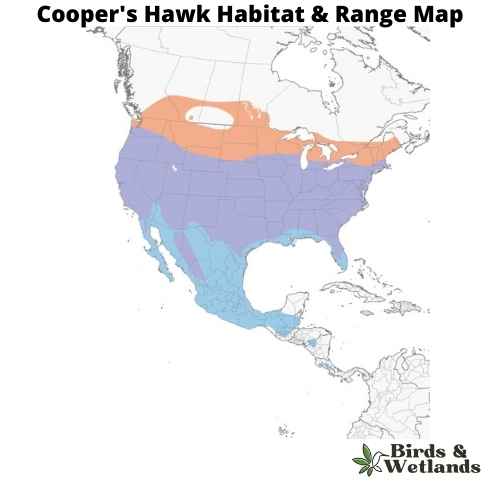
Listen:
The Cooper’s Hawk is a medium-sized bird of prey native to North America. Known for its agility and speed, it is part of the Accipitridae hawk species, which also includes other hawks, eagles, and kites.
Cooper’s Hawks are typically about 14 to 20 inches in length, with a wingspan ranging from 27 to 36 inches. They are known for their distinctive long, rounded tails and short, rounded wings. They have a steely blue gray top, with rusty bars on their underparts and thick, dark bands on their tails.
The Cooper’s Hawk is a skilled predator, primarily hunting birds and small mammals. They are adept at hunting in both dense forests and open areas, often catching prey mid-air in high-speed pursuits. They have also been known to visit the backyard bird feeder, not for the seed, but to prey on the smaller birds that gather there.
Cooper’s Hawks often build nests in dense tree canopies where they are well concealed. The female usually lays 3 to 5 eggs, and both parents share incubation duties. The young hawks fledge after about a month but will stay close to the nest, relying on their parents for food as they learn to hunt.
Short-tailed Hawk (Buteo brachyurus)
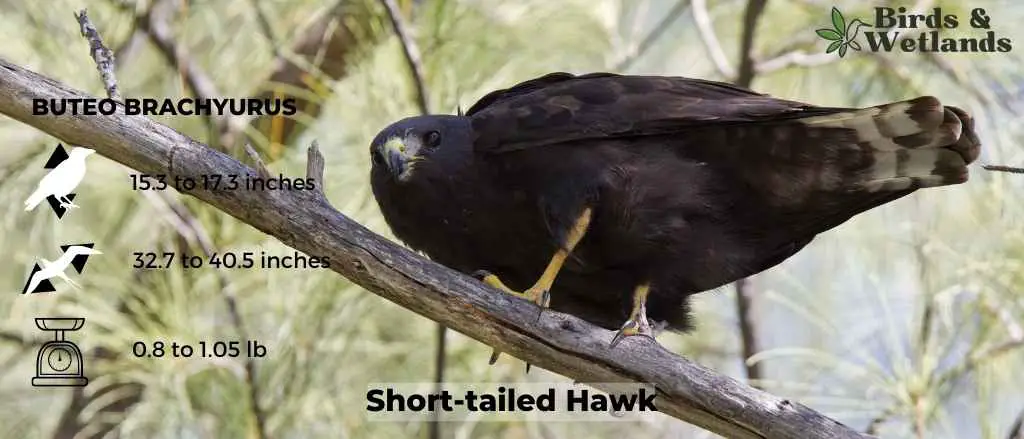
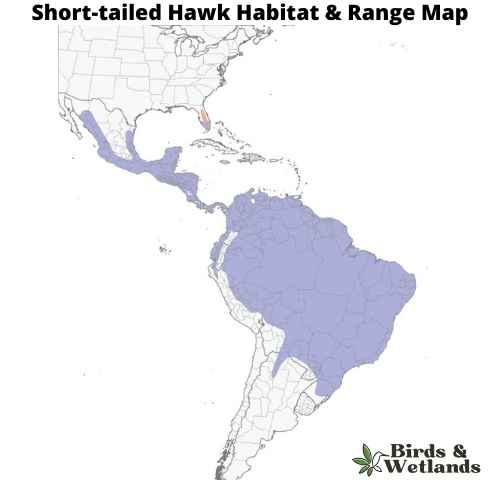
Short-tailed Hawk Sound
Scientific Name: Buteo brachyurus
Length: 15.3-17.3 in
Wingspan: 32.7-40.5 in
Weight: 13.6-16.9 oz
The Short-tailed Hawk is a small to medium-sized bird of prey native to the Americas.
Short-tailed Hawks are distinctive for their size and color variations. Adult individuals usually measure between 33-41 centimeters in length, with relatively short tails, giving them their common name. This species exhibits two color morphs, a dark morph and a light morph, with the darker morph being more prevalent in some areas. Both morphs possess a white rump and a broad, rounded wing shape.
The diet of the Short-tailed Hawk primarily consists of other birds, which they catch with a unique hunting strategy. They are often seen soaring high in the sky and will plummet in a fast stoop to capture prey unaware. This bird of prey is a master at utilizing thermals to soar high in the sky and can often be found circling in the air on warm days.
Short-tailed Hawks typically lay 1-3 eggs. The female incubates the eggs while the male brings her food. After hatching, the young birds stay in the nest for several weeks, with both parents providing food until they are ready to fledge.
Red-tailed Hawk (Buteo jamaicensis)
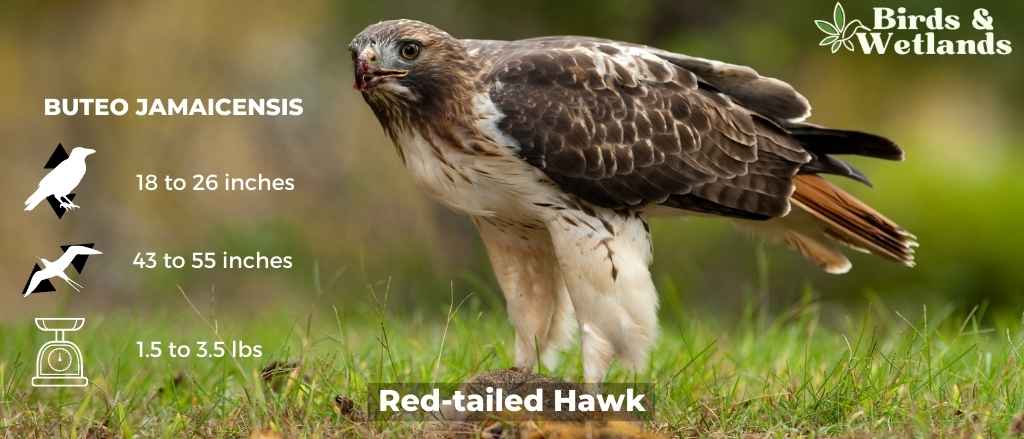
The Red-tailed Hawk is a large bird of prey that is commonly found across North America. This species is part of the genus Buteo, which is often referred to as the “true hawks,” and includes more than two dozen species of raptors.
Red-tailed Hawks have a robust size, ranging from 18 to 26 inches in length and sporting a wingspan that can exceed 4 feet. They have a broad, rounded set of wings and a short, wide red tail. This species is most easily recognized by its rich, rust-colored tail, which gives it its common name. However, juvenile hawks might not yet have this distinctive feature.
Their feathers are generally dark brown on their dorsal side (back) with a lighter, often speckled, ventral side (front). The intensity and pattern of their plumage can vary significantly based on their age and geographic location, as there are about 14 recognized subspecies of Red-tailed Hawks.
As for their diet, Red-tailed Hawks are carnivores and have a broad diet that includes rodents, ground rabbits, reptiles, and other birds. They are skilled hunters that typically sit on high perches and use their keen eyesight to spot potential prey. Once they have identified a target, they swoop down to capture it with their powerful talons.
Red-tailed Hawks mate for life and build nests high off the ground, often in tall trees or on cliff edges. Their nests are made of sticks and can be quite large. They typically lay 1-3 eggs per year, which are incubated by both parents.
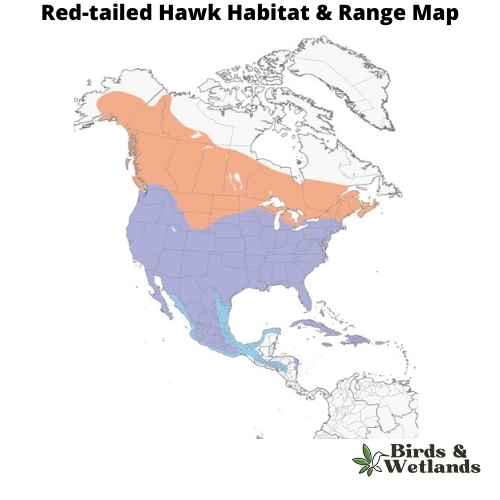
Red-tailed Hawk Sound
Red-shouldered Hawk (Buteo lineatus)
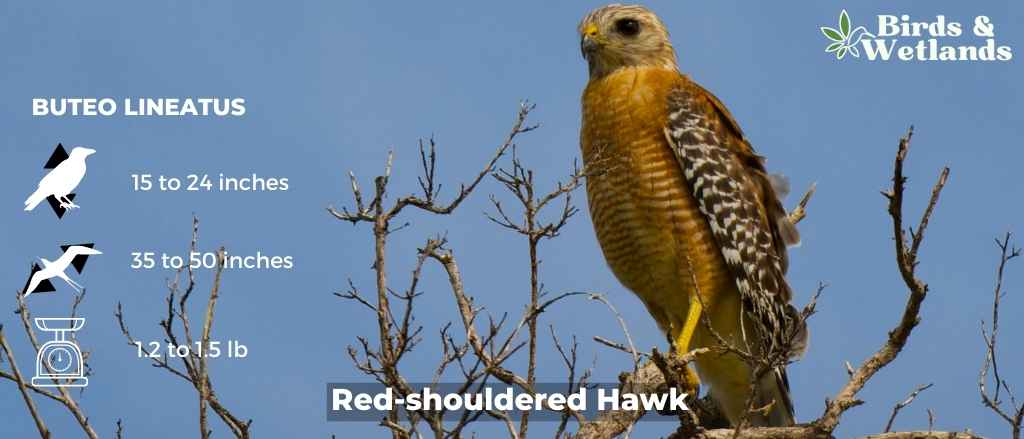
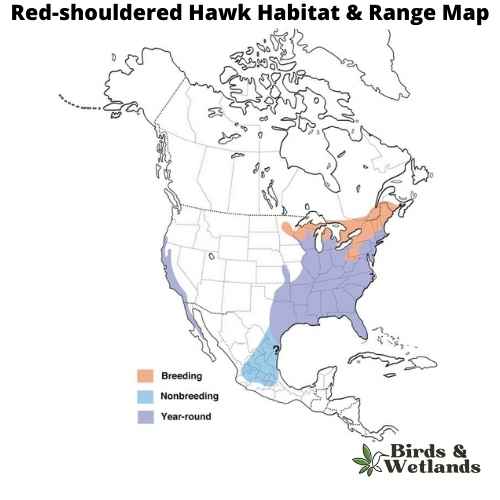
Listen:
The red-shouldered hawk are medium sized birds of prey, part of the buteo hawks family. It can be distinguished from other hawks by its reddish iris and pale legs.
The adult has rusty red upperparts, white underparts, a black chin and throat, and a reddish brown stripe over each eye, reddish brown heads and a strongly banded tail. The tail is reddish brown with two paler bands across it and they have white checkered wings. Juveniles are brown with dark barring and have pale fringes on the feathers of their wings.
Red-shouldered hawks nest in trees, though they also inhabit manmade structures including barns, bridges, and buildings. They prefer wooded areas with an open canopy but will use other places as well for nesting such as shrubs and hedges if needed.
The red-shouldered hawk’s diet – they eat small mammals such as ground squirrels, rabbits, voles, mice and rats. They also eat birds such as quail, pigeons and doves; reptiles including snakes; amphibians; fish; crustaceans; insects; and carrion (dead animals).
Broad-winged Hawk (Buteo platypterus)
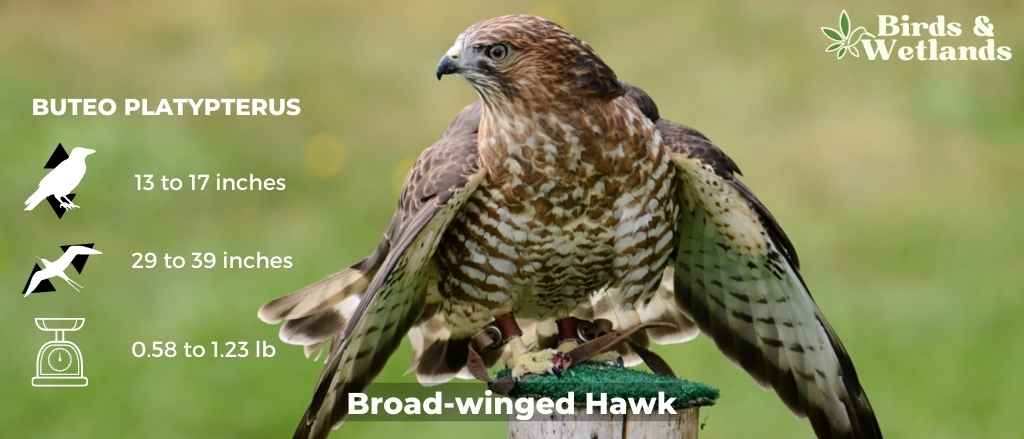
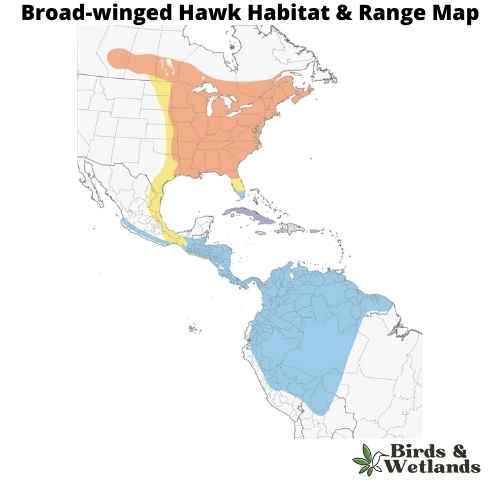
Broad-winged Hawk Sound
The Broad-winged Hawk holds a commanding presence as one of the largest hawks in the world, known for its broad wings. Its formidable size is a testament to its prowess as a bird of prey, effortlessly navigating the open skies in search of food.
Their distinctive appearance sets them apart. The adults exhibit a striking black and white pattern, complemented by a rusty breast and buff underparts and brown wings. In contrast, juveniles are adorned with a brown plumage, marked by pale edges on their feathers, adding to their distinctive youthful charm.
These hawks are most commonly found in open areas, such as farmlands or grasslands interspersed with scattered trees, which provide optimal conditions for when hawks hunt.
When it comes to their diet, Broad-winged Hawks feed on small rodents like mice, rats, squirrels, rabbits, and voles. Broad winged hawks breed during the spring and summer months then migrate to central and south America.
Mississippi Kite (Ictinia mississippiensis)
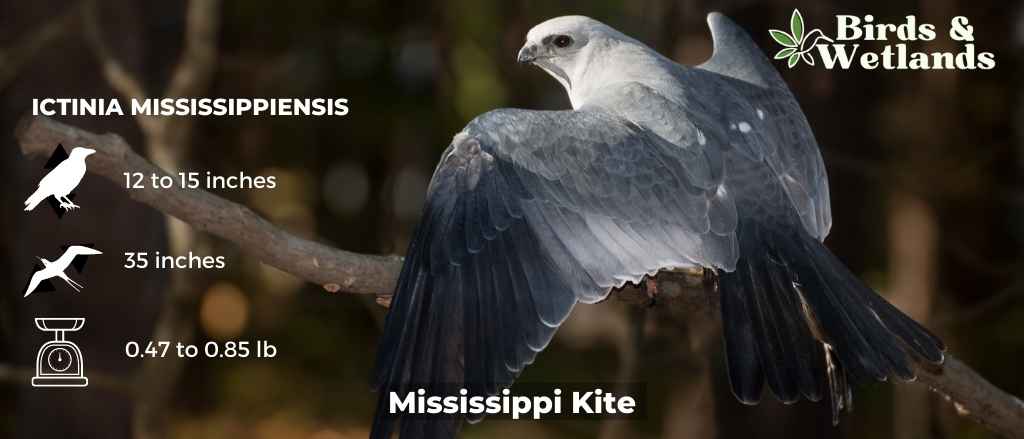
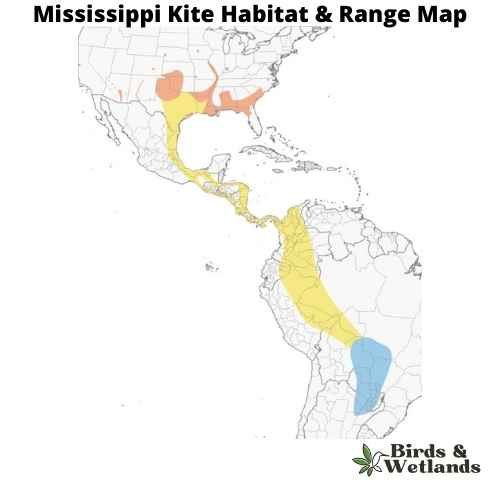
Mississippi Kite Sound
Scientific Name: Ictinia mississippiensis
Length: 12 to 15 inches (30–37 cm)
Wingspan: 3 feet (91 cm)
Weight: 214 to 388 grams (7.6–13.7 oz)
The Mississippi kite is a medium-sized bird of prey native to North America. It has a white belly and chest, with brown wings and tail and pointed wings. They have a black mask on their face, and the males have blue markings on their wings.
The Mississippi kites habitat is open grassland, including prairies, pastures, and meadows. It can also be found in wetlands such as marshes and swamps. It prefers warmer climates but can survive in cooler regions if there are many trees nearby that provide nesting sites.
The diet of these birds consists mostly of insects such as grasshoppers, beetles and dragonflies. They also eat small rodents that they catch while flying over fields or while perched on tall trees or telephone poles.
The Mississippis kite nest looks like a shallow bowl built with sticks, twigs and grasses. They lay between 2-5 eggs per year, which take about two weeks to hatch into chicks that fledge after two months. The breeding season for Mississippi Kites typically occurs from May to July
White-tailed Kite (Elanus leucurus)
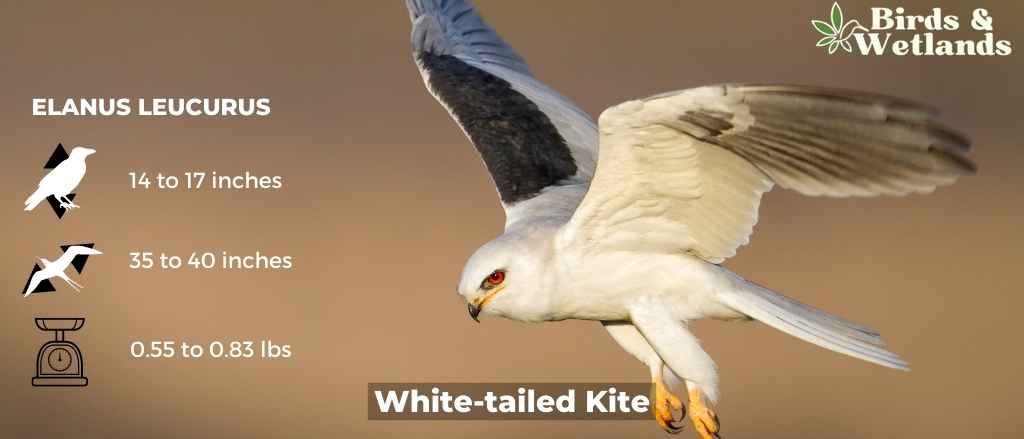

White-tailed Kite Sound
Scientific Name: Elanus leucurus
Length: 14–17 in
Wingspan: 35–40 in
Weight: (8.8–13.4 oz
The White-tailed Kite is a medium-sized bird of prey that is found throughout the Americas, from the western United States down through Central America and into South America.
White-tailed Kites have a striking appearance, with a white body, grey wings, and black shoulders. Their wings are long and pointed, giving them an elegant, buoyant flight. They get their name from their long, white tail.
They are primarily found in open grasslands, marshes, and savannas, often near bodies of water. They are known for their distinctive hunting technique, where they hover in the air before dropping onto their prey.
Their diet mainly consists of small rodents, especially voles and mice, which they hunt during the day. They are especially skilled at hunting in grassy habitats, where they can spot the movement of their prey from a distance.
White-tailed Kites are monogamous birds, with pairs building nests together in the tops of trees. They usually lay 3-5 eggs, which are incubated by both parents. After hatching, both parents take turns feeding the young.
Northern Harrier (Circus hudsonius)
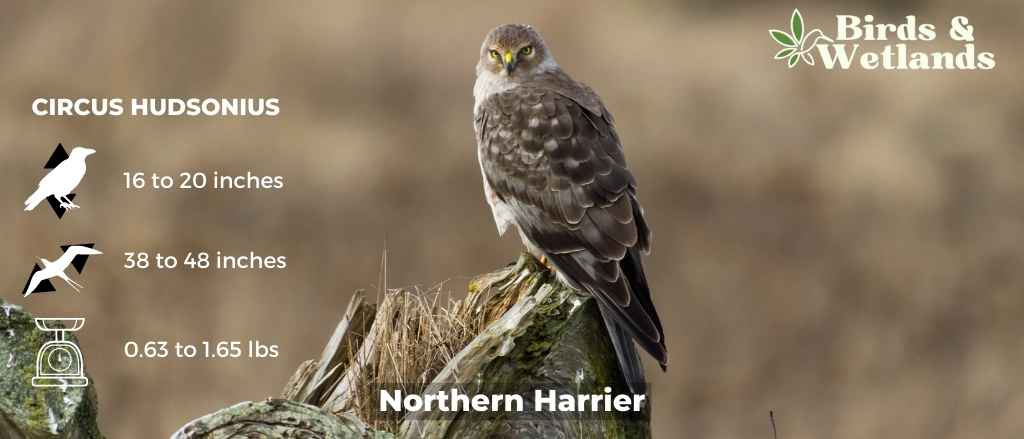
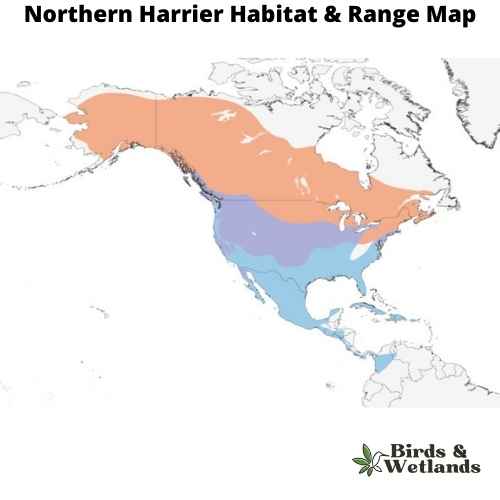
Listen:
The Northern Harrier is a medium-sized, slender hawk.
Adult birds are gray above, with pale bars on the wing feathers and white markings on the underwings and a white rump patch. The breast is barred with black and white, and the belly is streaked with brown.
They prefer open areas, such as grasslands and marshes, but can be found in almost any open habitat except dense woods.
Northern Harriers are opportunistic hunters that feed on small mammals such as mice, voles and rabbits as well as birds including quail, grouse and ducks. They hunt by flying low over open spaces such as fields or marshes.
Northern harrier nests on the ground in lowlands or hillsides near water bodies. It lays two to four eggs which hatch after 24 days of incubation by both parents. The chicks fledge after 30 days of hatching and remain dependent on their parents for another three weeks during which they learn how to fly.
Snail Kite (Aquila chrysaetos)
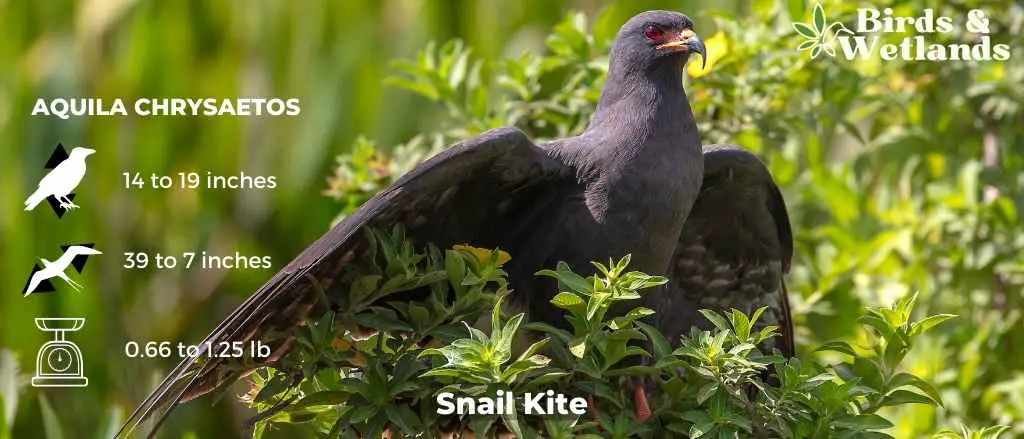

Snail Kite Sound
Scientific Name: Rostrhamus sociabilis
Length: 14 to 19 in
Wingspan: 39–47 in
Weight: 11 to 20 oz
The Snail Kite is a bird of prey that is unique due to its specialized diet. It primarily feeds on apple snails, a large freshwater snail species.
Male Snail Kites are slate gray with a white patch under the tail and red eyes. Females and young birds are brown with streaking on the underparts. All Snail Kites have a long, curved bill adapted for extracting snails from their shells.
The Snail Kite inhabits freshwater marshes and the shallow edges of lakes, where apple snails thrive. It is found in Florida, the Caribbean, and Central and South America.
As mentioned, its diet almost exclusively comprises apple snails. The bird uses its specialized bill to extract the snail from its shell. The decline in snail populations due to habitat loss or water pollution can therefore significantly impact the Snail Kite.
Nesting usually occurs in colonies over water. They build nests in shrubs or trees, where the female lays 1-4 eggs. Both parents take part in incubating the eggs and caring for the young.
Barred Owl (Strix varia)

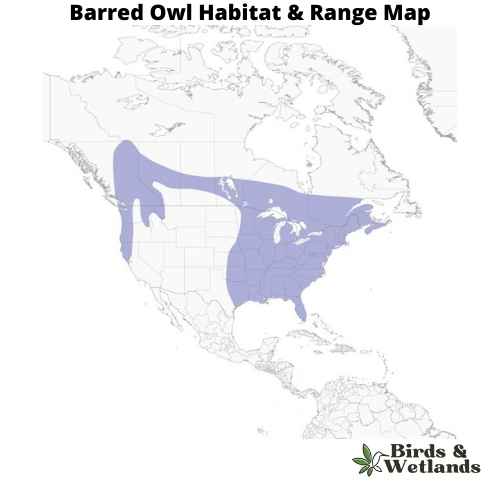
Barred Owl Sound
Scientific Name: Strix varia
Length: 40 to 63 cm (16 to 25 in)
Wingspan: 96 to 125 cm (38 to 49 in)
Weight: 468 to 1,150 g
The Barred Owl is a medium-sized owl with a barred pattern on its chest and belly. They have large yellow eyes that allow them to see well in low light conditions. Their ears are not very large which means they do not hear very well but they have excellent hearing abilities which allow them to detect sounds up to 1 mile away. Their feathers are brown and streaked with white, and they have black bars on their chests and wings.
Their habitats include forests, woodlands, orchards, parks, farmland and suburban backyards.
Barred Owls (also known as hoot owl) eat small mammals such as mice, rats and squirrels. They also eat insects such as beetles or grasshoppers. These owls hunt during the day when it is light out so that they can see their prey better than at night when they would be using senses other than sight like sound or smell to find their food source.
Barred owls are monogamous birds which means they mate for life. They build nests in trees or cavities on the ground and lay 2-4 eggs per year. The incubation period for these eggs lasts about 28 days before hatching takes place.
Great Horned Owl (Bubo virginianus)

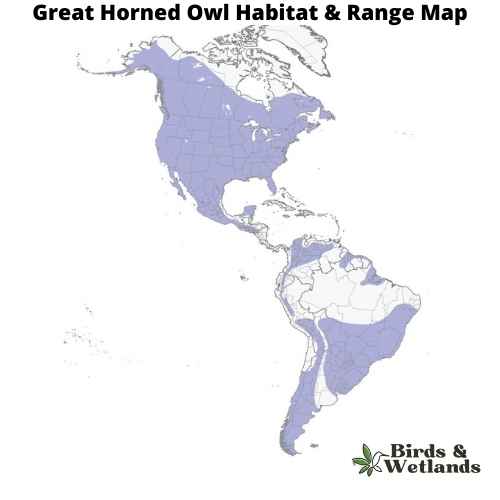
Great Horned Owl Sound
Scientific Name:Bubo virginianus
Length: 18.1-24.8 in
Wingspan: 39.8-57.1 in
Weight: 32.1-88.2 oz
The Great Horned Owl is a large owl with long wings and a large head. It’s one of the most common owls in North America.
Great Horned Owls are large, stocky birds with soft feathers that are gray to brown on their backs and white on their chests. Their faces are characterized by two black “ear” tufts, which can be raised or flattened depending on the owl’s mood. The eyes are yellow, orange, or red in color.
The habitat of the Great Horned Owl is a variety of different environments such as forests and deserts. They also live near water sources such as lakes, streams and rivers where they can hunt for fish.
The diet of the Great Horned Owl consists primarily of small mammals such as mice and rats; however they will also eat other rodents such as squirrels, rabbits and porcupines. They have been known to eat skunks too.
Turkey Vulture (Cathartes aura)
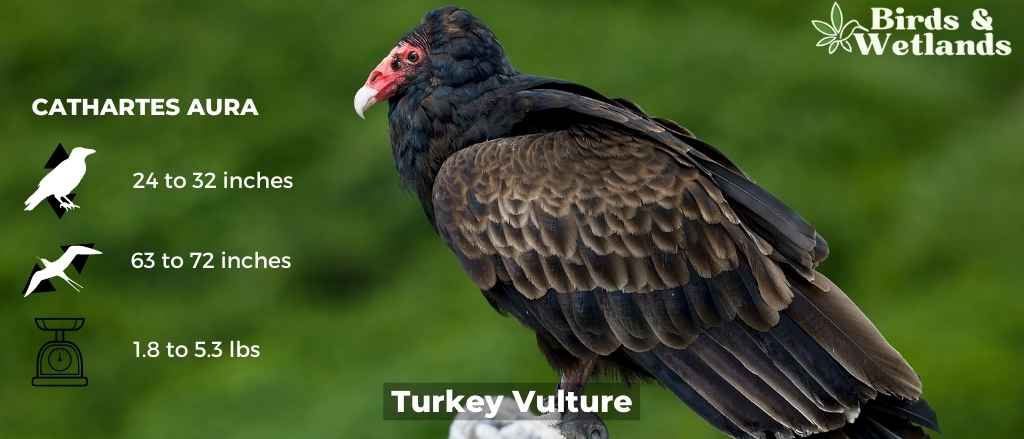
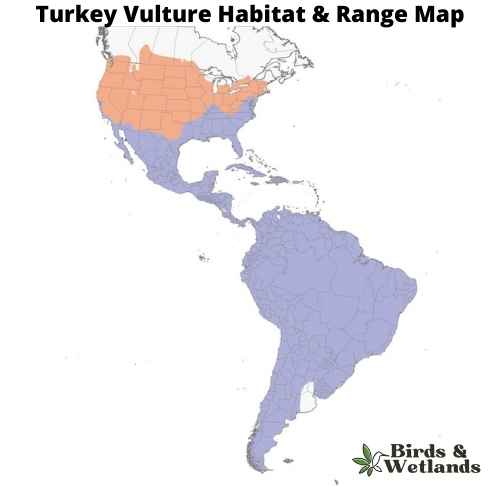
Turkey Vulture Sound
Scientific Name: Cathartes aura
Length: 24–32 in
Wingspan: 63–72 in
Weight: 1.8 to 5.3 lb
Turkey vultures are large birds that are easily recognizable by their bald heads, which are black in coloration, and by the patch of red skin below their beaks. It is white with black spots on the wings and tail. It has a bald head and a hooked beak that is black in coloration.
Turkey vultures live in the Americas, Europe, Africa, and Asia. They can be found in deserts, grasslands, forests and swamps. Turkey vultures are found throughout North America and parts of Central America and South America. In the U.S., they can be found across the country, but most commonly in the southwest region.
Turkey vultures eat carrion—dead animals’ remains such as dead deer, sheep, cows, horses and other large mammals that have been killed by other predators, such as coyotes or foxes. They do not hunt live prey.
The Black Vulture (Coragyps atratus)
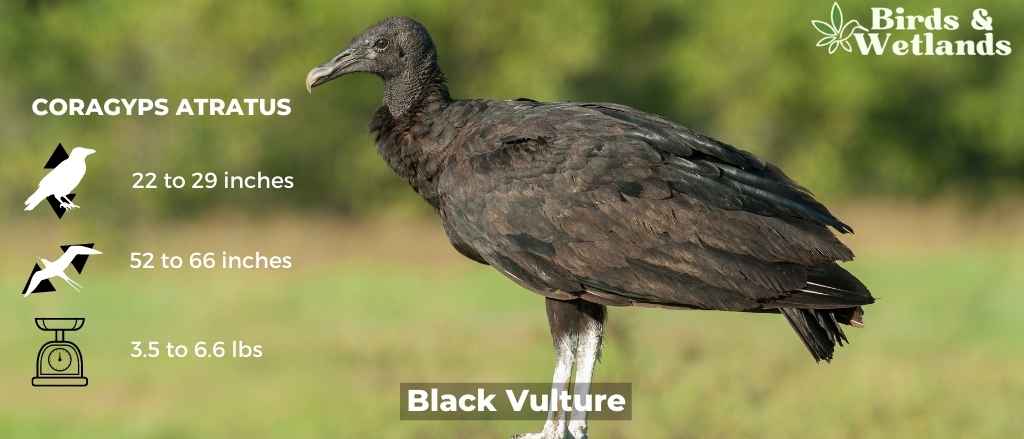
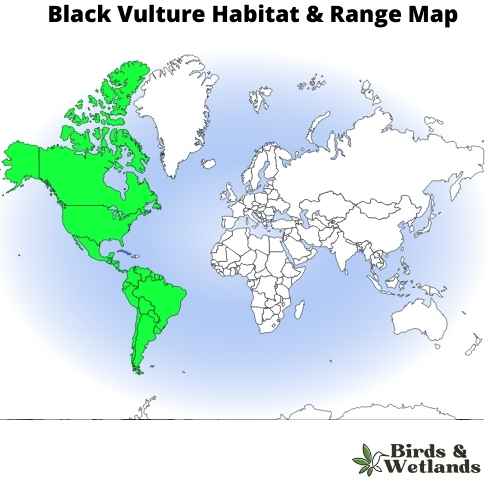
Black Vulture Sound
Scientific Name: Coragyps atratus
Length: 22–29 in
Wingspan: 52–66 in
Weight: 3.5 to 6.6 lb
The Black Vulture is easily recognizable by their black plumage, short, square tail, and their bald black head.
These birds are scavengers and play a vital role in the ecosystem by feeding primarily on carrion (dead animals). They are known to occasionally kill smaller, weakened animals, but such behavior is not the norm. Black Vultures locate food using their excellent sense of sight and by following other vultures.
Unlike most birds, Black Vultures are not known to build traditional nests. Instead, they lay their eggs in sheltered areas like hollow trees, abandoned buildings, or thickets. They typically lay two eggs, and both parents will incubate and care for the chicks.
Black Vultures are social birds that are often seen in large groups. They roost together in large numbers and are known to even forage in groups. They can often be seen soaring on thermals during the day, hardly flapping their wings, while looking for food.
Osprey (Pandion haliaetus)

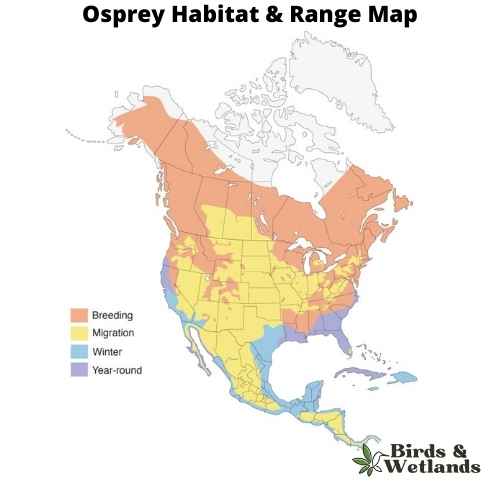
Osprey Sound
Scientific Name: Pandion haliaetus
Length: 50–66 cm (19+1⁄2–26 in)
Wingspan: 127–180 cm (50–71 in)
Weight: 0.9–2.1 kg (2 lb 0 oz – 4 lb 10 oz)
The Osprey, a fascinating bird of prey, is universally known for its exceptional hunting prowess and striking physical characteristics. Osprey are dark brown hawks on the upperparts, contrasting beautifully with the predominantly white underparts, and a distinctive dark band that stretches across the eyes towards the sides of its head.
Equipped with specialized talons and a reversible outer toe, the Osprey’s hunting strategy involves a spectacular plunge-dive into bodies of water, often emerging with a fish securely gripped in its claws.
Found on every continent except Antarctica, the Osprey is a cosmopolitan species favoring habitats near water bodies such as lakes, rivers, and coastal areas, reflecting its piscivorous diet. This bird has a diet almost exclusively of fish, making it a unique member of the raptor family and often referred to as the sea hawk or fish hawk. They locate their prey from the air, often hovering before plunging feet-first to capture a fish. When it comes to breeding, Ospreys are monogamous, often mating for life.
They construct large, bulky nests made of sticks, lined with softer materials, and prefer elevated or isolated areas such as treetops or artificial structures like utility poles. Both parents share the responsibility of incubating the eggs and rearing the chicks.
Limpkin (Aramus guarauna)
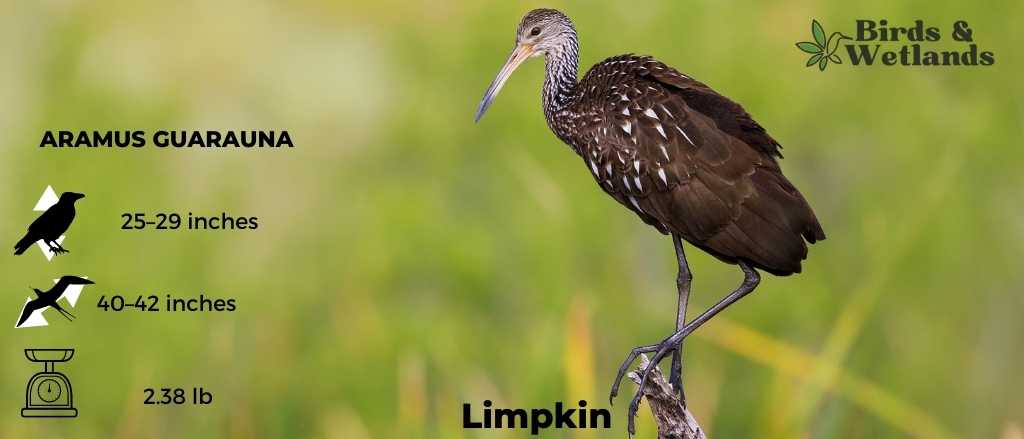
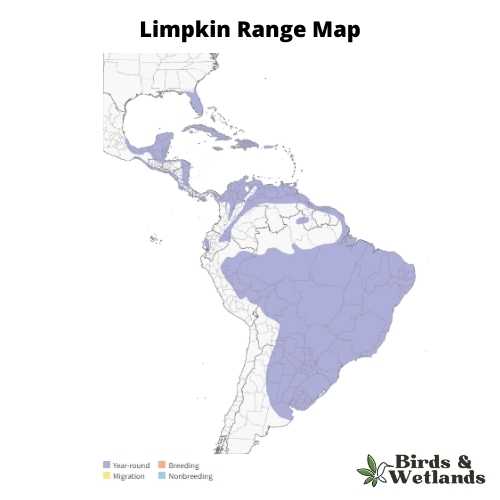
Limpkin Sound
Scientific Name: Aramus guarauna
Length: 25–29 in
Wingspan: 40–42 in
Weight: 2.38 lb
The Limpkin also known as the “crying bird”, is a large, long-legged bird native to wetlands in the Americas.
The Limpkin primarily feeds on apple snails (genus Pomacea) and, in some regions, mussels. It uses its long, curved bill to extract the snail from the shell.
Physically, the Limpkin is somewhat crane-like with its long legs and neck but is more closely related to rails and cranes. It has dark brown feathers with a slight sheen, and its body is streaked with white.
Limpkins are primarily solitary and can be found in freshwater marshes and swamps, along riverbanks, and around ponds and lakes. They are mostly active at night or near dusk, making them relatively difficult to spot.
The Limpkin is known for its unique and mournful call, often described as a wailing cry, which it typically vocalizes at night.
Limpkins build platform nests out of rushes and sedges, and they typically lay between four and eight eggs.
Where to Spot Florida Birds of Prey
1. Everglades National Park: As one of the largest national parks in the U.S., the Everglades offers a rich variety of birds of prey, including Ospreys, Red-shouldered Hawks, and Snail Kites. The River of Grass is an excellent place to spot these magnificent creatures.
2. Merritt Island National Wildlife Refuge: Situated near Cape Canaveral, this refuge is home to many species of raptors, including Bald Eagles, Peregrine Falcons, and various types of hawks. A visit here may offer a rare glimpse of a nesting pair of Bald Eagles.
3. Ding Darling National Wildlife Refuge: This refuge, located on Sanibel Island, is an excellent location for birdwatching, boasting a wide variety of species, including Ospreys and Red-tailed Hawks.
4. Corkscrew Swamp Sanctuary: Near Naples, this sanctuary is an Audubon Center and hosts a diversity of raptors, from the Barred Owl to the Cooper’s Hawk. blue gray wings
5. St. Marks National Wildlife Refuge: Located in the Panhandle, this refuge is a wintering ground for many migratory birds of prey, including the Peregrine Falcon and the American Kestrel.
As fascinating as Florida’s raptors are, the journey doesn’t stop at the state border. Venture north to discover the impressive birds of prey in Georgia. The Peach State’s diverse habitats serve as a rich tapestry of life for a multitude of hawks, eagles, and falcons. For a different perspective, cross the state line westward into Alabama hosts a myriad of magnificent preying birds, each species with its own unique allure. Our comprehensive master guide to US Birds of Prey takes you across the country, spotlighting the remarkable variety that grace the skies of America.

